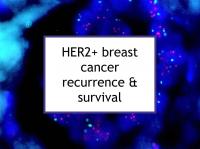Data published since 2019 concerning survival of women with early-stage invasive HER2 overexpressing (HER2+) breast cancer is summarized below. However, please note that outcomes can vary depending on numerous factors and the data represents snapshots from studies that were conducted under a variety of circumstances.
Furthermore, most studies that calculate survival do not present the results as simple percentages. Therefore, the numbers below are somewhat inconsistent and far from complete or definitive and should not be used to calculate your likely recurrence-free survival. However, the statistics are useful in getting a general idea of HER2+ breast cancer prognosis and to compare outcomes depending on treatment and other factors. For example, the data suggests that patients who do not achieve a pathologic complete response to neoadjuvant chemotherapy have worse outcomes and therefore might benefit from additional monitoring and treatment.
Definition of recurrence & survival terms
Overall survival means that no death occurred from any cause (this includes deaths from both breast cancer and non-breast cancer-specific causes). Breast cancer-specific survival refers to the percentage of patients who did not die from breast cancer during the specified period. Progression-free survival means that no recurrence, metastasis or breast cancer-related death took place during the specified period. Recurrence-free survival was defined by the authors who used the term in one study as no recurrence, metastasis or breast cancer-related death, however a second primary cancer might have been diagnosed during follow up. PCR or minimal residual cancer burden (RCB-I) means no or very little remaining microscopic evidence of viable cancer cells in tissue biopsied after treatment.
HER2+ breast cancer recurrence & survival data
Patient & treatment characteristics → Likelihood of 5-year survival
ER+/PR+/HER2+ receptor status
- 5-year survival
- ER+/PR+/HER2+ Overall survival → 84%
- ER+/PR+/HER2+ Breast cancer-specific survival → 91%
- 5-year progression-free survival based on chemotherapy
- ER+/PR+/HER2+ Adjuvant chemotherapy, no trastuzumab (Herceptin) → 56%
- ER+/PR+/HER2+ Neoadjuvant chemotherapy, no trastuzumab → 65%
- ER+/PR+/HER2+ Neoadjuvant chemotherapy plus trastuzumab → 89%
- 5-year progression-free survival based on residual disease
- ER+/PR+/HER2+ RCB-I after neoadjuvant treatment → 93% to 98%
- ER+/PR+/HER2+ Moderate residual cancer burden (RCB-II) → 78%
- ER+/PR+/HER2+ Extensive residual cancer burden (RCB-III) → 49%
- 5-year progression-free survival based on degree of ER & PR positivity
- ER+/PR+/HER2+ Both ER and PR scores ≥ 50%, adjuvant chemotherapy plus trastuzumab → 75%
- ER+/PR+/HER2+ ER and/or PR scores < 50%, adjuvant chemotherapy plus trastuzumab → 81%
ER-/PR-/HER2+ receptor status
- 5-year survival
- ER-/PR-/HER2+ Overall survival → 79%
- ER-/PR-/HER2+ Breast cancer-specific survival → 86%
- 5-year progression-free survival with neoadjuvant treatment overall
- ER-/PR-/HER2+ Neoadjuvant chemotherapy plus trastuzumab → 83%
- 5-year progression-free survival with or without residual disease
- ER-/PR-/HER2+ RCB-I after neoadjuvant treatment → 88% to 96%
- ER-/PR-/HER2+ RCB-II after neoadjuvant treatment → 60%
- ER-/PR-/HER2+ RCB-III after neoadjuvant treatment → 45%
Mixed hormone receptor status
- 5-year survival: ER+/PR-
- ER+/PR-/HER2+ Overall survival → 81%
- ER+/PR-/HER2+ Breast cancer-specific survival → 88%
- 5-year survival: ER-/PR+
- ER-/PR+/HER2+ Overall survival → 79%
- ER-/PR+/HER2+ Breast cancer-specific survival → 85%
HER2+ where hormone receptor status was not specified
- 5-year progression-free survival with and without trastuzumab
- HER2+ Standard of care treatment, 12 months trastuzumab → 94%
- HER2+ Standard of care treatment, less than 12 months trastuzumab → 80% to 87%
- HER2+ PCR after neoadjuvant chemotherapy, no trastuzumab → 68%
- HER2+ At least one positive lymph node, neoadjuvant chemotherapy plus trastuzumab plus radical mastectomy → 82%
- 8-year progression-free survival with adjuvant treatment
- HER2+ Adjuvant chemotherapy + concurrent trastuzumab → 82% eight-year recurrence-free survival
- HER2+ Adjuvant chemotherapy followed by trastuzumab → 79% eight-year recurrence-free survival
ER+/PR+/HER2+ by estimated risk status*
- Low risk ER+/PR+/HER2+ → 84% 10-year overall survival
- Intermediate risk ER+/PR+/HER2+ → 75% 10-year overall survival
- High risk ER+/PR+/HER2+ → 63% 10-year overall survival
*Low risk defined as either (1) tumor size ≤2 cm, 0-3 positive lymph nodes and histological grade 1; (2) tumor size 2.1-3 cm, node-negative and histological grade 1; (3) tumor size ≤2 cm, node-negative and histological grade 2; or (4) tumor size ≤1 cm, node-negative and histological grade 3.
Intermediate risk defined as either (1) tumor size ≤2 cm, node negative and histological grade 2; (2) tumor size 3.1-4.9 cm, ≤3 positive lymph nodes and histological grade 1; (3) tumor size ≥5 cm, node-negative and histological grade 1; (4) tumor size 2.1-4.9 cm, 0-3 positive lymph nodes and histological grade 2; (5) tumor size ≥5 cm, node negative and histological grade 2; or (6) tumor size ≥1 cm, node negative and histological grade 3.
High risk defined as either (1) tumor size ≥5 cm and ≥1 positive lymph nodes +; (2) ≥4 positive lymph nodes; or (3) histological grade 3.
Below are links to recent studies concerning this topic. Please also see our article on HER2+ breast cancer prognosis, which describes factors that drive outcomes in this type of breast cancer.
